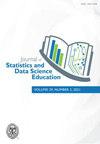时间逻辑是否能改善有向无环图(dag)的规范?
IF 1.6
Q2 EDUCATION, SCIENTIFIC DISCIPLINES
Journal of Statistics and Data Science Education
Pub Date : 2021-06-02
DOI:10.1080/26939169.2021.1936311
引用次数: 1
摘要
摘要时间驱动的协变量分类对85名新手分析师(医学本科生)对有向无环图(DAG)的规范影响有限;或DAG多变量模型中的偏差风险,该模型旨在从观测数据中产生因果推断。只有71名学生(83.5%)成功完成了“时间驱动的协变量分类”任务,完成“DAG规范”任务(77.6%)或连续完成两项任务(68.2%)的学生更少。大多数完成第一项任务的学生至少对一个协变量进行了错误分类(84.5%),指定DAG的学生的错误分类率更高(92.4%)。尽管如此,在每项任务考虑的512和517个协变量中,“混杂因素”被错误分类的可能性(11/252,4.4%和8/261,3.1%)远低于“中介因素”(70/123,56.9%和56/115,48.7%)或“竞争暴露”(93/137,67.9%和86/138,62.3%)。由于在多变量模型中对总因果效应的估计是有偏差的,这些模型:未能调整“混杂因素”;或根据被错误归类为“混杂因素”或“竞争暴露”的“媒介”(或“结果的后果”)进行调整,本研究DAG所提供的任何模型中,很大一部分都会对总因果效应产生有偏差的估计(50/66,76.8%);对于仅由时间驱动的协变量分类提供信息的模型,这一比例仅略低(47/71,66.2%)。本文的补充材料可在线获取。本文章由计算机程序翻译,如有差异,请以英文原文为准。
Might Temporal Logic Improve the Specification of Directed Acyclic Graphs (DAGs)?
Abstract Temporality-driven covariate classification had limited impact on: the specification of directed acyclic graphs (DAGs) by 85 novice analysts (medical undergraduates); or the risk of bias in DAG-informed multivariable models designed to generate causal inference from observational data. Only 71 students (83.5%) managed to complete the “Temporality-driven Covariate Classification” task, and fewer still completed the “DAG Specification” task (77.6%) or both tasks in succession (68.2%). Most students who completed the first task misclassified at least one covariate (84.5%), and misclassification rates were even higher among students who specified a DAG (92.4%). Nonetheless, across the 512 and 517 covariates considered by each of these tasks, “confounders” were far less likely to be misclassified (11/252, 4.4% and 8/261, 3.1%) than “mediators” (70/123, 56.9% and 56/115, 48.7%) or “competing exposures” (93/137, 67.9% and 86/138, 62.3%), respectively. Since estimates of total causal effects are biased in multivariable models that: fail to adjust for “confounders”; or adjust for “mediators” (or “consequences of the outcome”) misclassified as “confounders” or “competing exposures,” a substantial proportion of any models informed by the present study’s DAGs would have generated biased estimates of total causal effects (50/66, 76.8%); and this would have only been slightly lower for models informed by temporality-driven covariate classification alone (47/71, 66.2%). Supplementary materials for this article are available online.
求助全文
通过发布文献求助,成功后即可免费获取论文全文。
去求助
来源期刊

Journal of Statistics and Data Science Education
EDUCATION, SCIENTIFIC DISCIPLINES-
CiteScore
3.90
自引率
35.30%
发文量
52
审稿时长
12 weeks
 求助内容:
求助内容: 应助结果提醒方式:
应助结果提醒方式:


